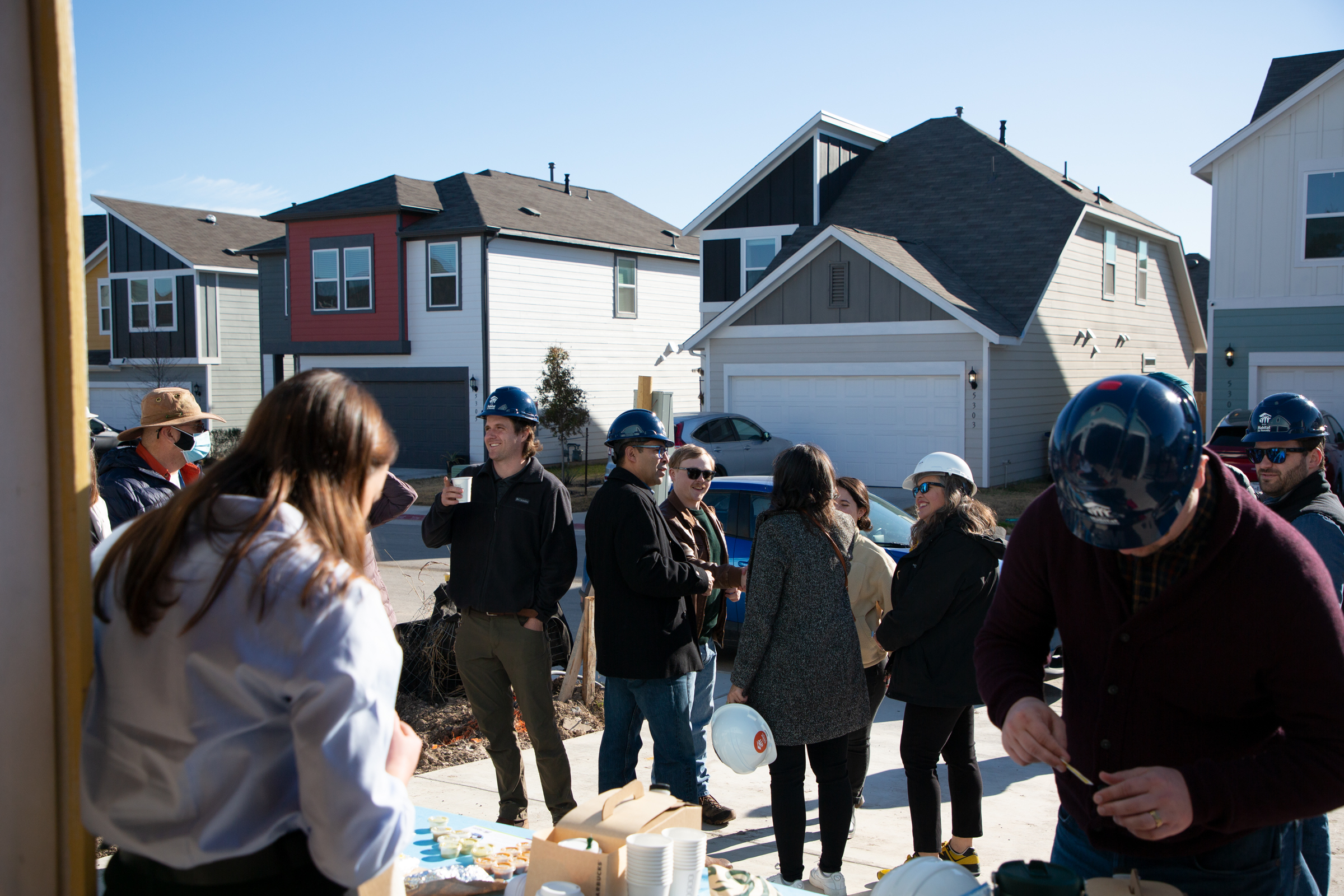In 2019, Mike Stratton, a high school math teacher and coach, was ready to call it quits on his yearslong hunt for an affordable single-family home in Austin’s red-hot real estate market and move out of the city.
Most of the houses under his $350,000 budget were dilapidated, 1,000-square-foot homes that were “basically tear downs,” he said. Stratton wanted to buy a home in the East Austin neighborhood where he was renting an apartment, but on a $52,000 salary the prices were beyond his reach.
“The lowest one we saw was for half a million dollars, and it needed some work,” Stratton said. “The market at the time was just outrageous.”
Then, Stratton caught a break. A nearby building development, Park at 51 East, was selling large single-family houses within his budget.
Stratton learned that the below-market-rate development was part of a larger effort by his employer, the Austin Independent School District, to create more housing opportunities for teachers and staff.
In September of last year, after COVID-related construction delays, Stratton and his wife finally moved into their newly constructed 4-bedroom, 2-and-a-half bath home in Austin, just over 2,000 square feet, all for about $300,000.
“It’s fantastic,” Stratton said. “It’s way more than we could have asked for.”
School districts in very expensive housing markets, like Austin, Denver, New York and across California, say they struggle to attract and retain educators. Starting teachers’ salaries can be in the low $50,000s, nowhere near enough to afford the median home prices that can range from close to half a million dollars in Austin to nearly $1 million in Los Angeles.
“California is having a huge problem with recruiting and retaining its education workforce, and not just teachers, but janitors and cafeteria workers — all the people who keep our schools running.”
With the persistent increase in housing prices, and budget-strapped schools unable to raise wages, an increasing number of districts are considering leveraging a valuable asset many have in abundance — land — and developing it into housing for teachers, staff and students and their families.
“The affordability issue in Austin continues to be a problem for the school district, not only for our staff but also for our families,” said Jeremy Striffler, director of real estate at Austin Independent School District.
Austin had one of the fastest-growing housing markets during the pandemic, with prices increasing by 45% in 2021. By September 2022, the median price for a home was $470,000.
“We think building housing that we can control the affordability of will at least give teachers an option,” Striffler said.
In 2017, the Austin school district started “dipping its toes” into affordable housing, Striffler said, selling property to a developer under an agreement that 25% of the proposed 200 homes be below-market rate and the school district’s staff have first dibs.
When pre-market sales for 30 of the homes awaiting construction opened to employees, Striffler said, “we got over 1,200 inquiries within one week.”
School districts moving into the affordable housing business have gained the most traction in California, where the median home price of $831,500 in 2022 is almost double the national median price, far out of reach for most teachers and school staff.
“California is having a huge problem with recruiting and retaining its education workforce, and not just teachers, but janitors and cafeteria workers — all the people who keep our schools running,” said Dana Cuff, director of University of California, Los Angeles’ cityLAB.
The teacher turnover rate in California was at 12% between 2016-17 and 2017-18, but a recent survey by the California Teachers Association and UCLA Center for the Transformation of Schools suggests the current turnover numbers are likely much higher, with four out of ten teachers surveyed saying they have considered leaving the profession. Although the top reasons reported were burnout, stress and political attacks on teachers, other complaints included low pay.
Additionally, Cuff pointed to anecdotal reports of teachers commuting long hours, sleeping in their cars and generally struggling to make ends meet. One news report highlighted a district in the Bay Area school that asked the families whose kids went to school there if they could offer rooms for teachers in need of housing.
“That was my lowest point, that the solution would be that a teacher would have to live in the extra bedroom of a kid’s family,” Cuff said. “Our children’s education — thus, the future of California — is at risk because we can’t house the people we should be honoring.”
Cuff is a co-author of Education Workforce Housing in California, a comprehensive report that lays out the potential of building affordable housing for educators and school staff on land owned by school districts. In researching the report, Cuff and her team at cityLAB discovered that California public school districts have a surplus of land, of which 75,000 acres statewide — “about the size of five Manhattans” — could potentially be developed into affordable housing.
Many California public school districts, both urban and rural, are interested in building housing but have run up against barriers: raising money and navigating the complex, regulated world of affordable housing.
Only two school districts — Los Angeles and Santa Clara — have built affordable housing, but 45 districts have tried to and failed, according to Cuff.
In September of last year, California Gov. Gavin Newsom signed legislation that will streamline the development of affordable housing on public school properties for teachers and school staff. The new law is slated to go into effect in January 2024.
If the law goes to plan, Cuff said, it should encourage more school districts to build housing as it will likely reduce the average development period from 10 to four years.
Los Angeles Unified School District, the second largest school district in the country, was an early pioneer in developing affordable housing with three below-market-rate housing projects to date.
The idea was the housing would be for its workforce — many of whom commute over an hour to get to school — but they hit a snag: none of the teachers qualified for below-market-rate housing. The project’s developers used tax credits to subsidize the project that set income limits just above Los Angeles’ starting salaries for teachers, at 60% below the area median income. The school district’s lease agreement with the developers didn’t give the district any control over income limits. However, other school staff — aides, cafeteria workers, custodians — are eligible to live in the housing complexes.
District officials say they hope to learn from their past blunders and have signaled they are likely to try again.
“I personally don’t think that school districts have a choice but to try and use as many vehicles and mechanisms as they can to begin to address this [housing] crisis — using their land is one of them,” said Al Grazioli, director of real estate and business development at the Los Angeles Unified School District.
Not everyone thinks the solution is for districts to get into real estate. Shawn Hindes, an eighth-grade social studies teacher in New York City, said he doesn’t think educators want to live in subsidized housing. Hindes is also a co-founder of Teacher Space New York, a residential brokerage service for teachers on a budget.
“Housing is important, but the real talk should be about how we pay our teachers and make it so they can survive,” Hindes said.
***
Brian Rinker is a San Francisco-based freelance writer and journalist. He covers public health, child welfare, digital health, startups and venture capital. His work has been published by Kaiser Health News, Health Affairs, The Atlantic, Men’s Health and San Francisco Business Times. Brian received master’s degrees in journalism and public health from UC Berkeley.






























